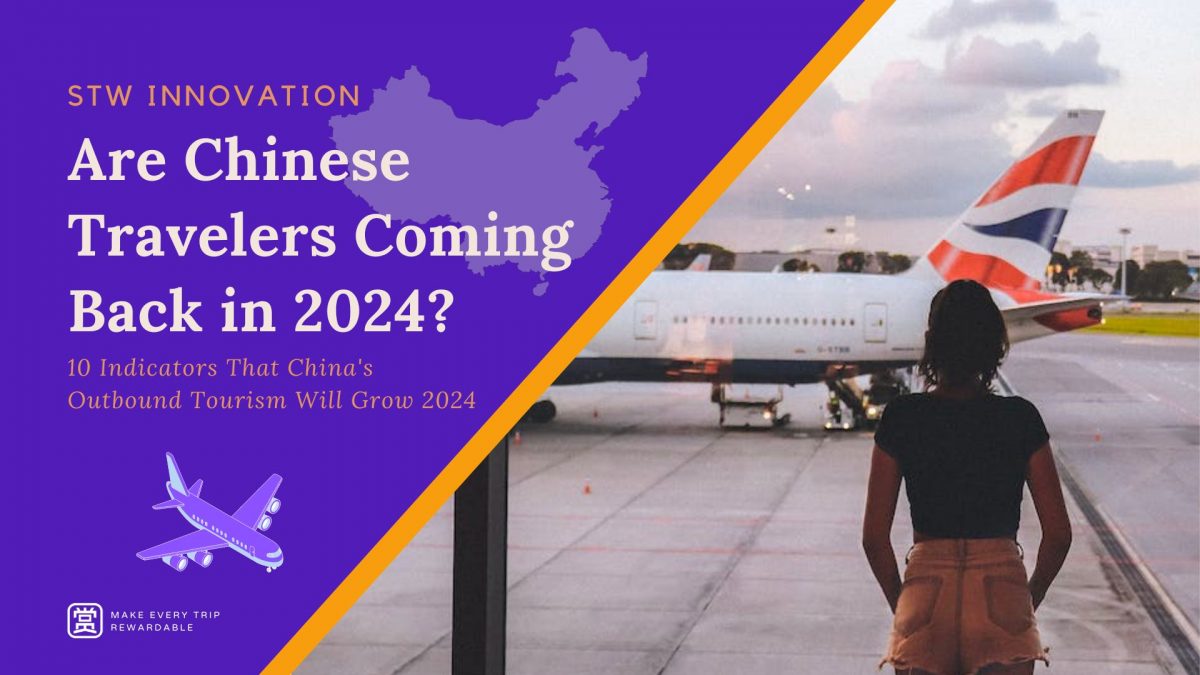10 Indicators That China’s Outbound Tourism Will Grow 2024
As we step into 2024, the resurgence of China’s outbound tourism signals a promising wave of exploration and cultural exchange. Despite the precautions for travel abroad by Chinese travelers in the previous year, this year shows hopeful signs of not only a full recovery but also an expected uprise in Chinese outbound travel. Let’s delve into ten compelling indicators, showcasing the robustness and vitality of Chinese outbound tourism this year:
1. Recovering Administrative Facilitation

The revival of administrative processes to handle Chinese passports and visas represents a crucial milestone. China’s Ministry of Culture and Tourism‘s announcement in August 2023, permitting travel agencies to resume tours to 138 countries for Chinese group tours, marks a significant step. While concerns about safety and visa backlogs initially slowed outbound travel, this stage signals the rehiring of staff and a gradual return to pre-pandemic norms.
2. Expanded Flight Connectivity

Witnessing an increase in flight routes between China and other countries is a clear sign of renewed confidence in international travel. Airlines are recalibrating their services, providing more options for Chinese travelers to reach diverse corners of the globe, and enhancing connectivity at more affordable prices.
The recent agreements to increase flight routes between China and other nations stand as a testament to renewed confidence in global travel. While domestic flights in China have rebounded strongly, international routes remain below pre-pandemic levels. There were 20,940 international flights recorded in China in August 2023. A stark difference from the less than 500 flights weekly since the beginning of 2023. This is less than half that of the same month in 2019. The Civil Aviation Administration of China aims to reach 80% of pre-COVID international flight levels by the end of 2024, fostering optimism for increased connectivity and travel frequency.
Furthermore, this year China is expected to promote the increase of 63 direct flights between China and the US as part of this changing tide. Aside from that tourism experts are taking note of China’s active role in easing visa requirements with the cooperation of foreign nations since it has waived visa requirements for several European nations.
3. Easing of Visa Requirements

The easing of visa restrictions is a game-changer, fostering diplomatic ties and expanding travel possibilities for Chinese tourists. Initiatives like unilateral visa-free policies and streamlined entry requirements especially in Southeast Asian countries have driven significant interest and economic recovery within those regions. As of January 2024, Chinese passport holders can explore 48 countries and territories without a visa, broadening the spectrum of accessible global destinations.
Southeast Asian countries such as Thailand, Brunei, and Singapore have already made the first move by removing visa requirements for Chinese travelers. Fliggy platform data showed a sharp increase in flight searches to Thailand following the announcements. According to a report by LY.com, Chinese interest in traveling abroad has shifted significantly. 60 percent of the report’s respondents expressed a desire to travel abroad within the next year.
4. Holiday Bookings Boom

A palpable surge in holiday bookings, especially preceding the Lunar New Year, reveals a profound desire among Chinese tourists to celebrate cultural festivities abroad. Notably, Southeast Asia emerges as a standout destination, with bookings surging by an astonishing 540% compared to the previous year’s Spring Festival. Fliggy reports a significant drop in New Year travel prices and a notable increase in mid to long-haul bookings, signifying a robust rebound in international travel demand.
At the same time, Tuniu, an online Chinese travel platform saw a surge in bookings for tourism products during the 8-day Lunar New Year holiday compared to the same period last year. Travel bookings were highest in the earlier days which is when Chinese travelers head back to reunite with their families.
While closer regions will be the most convenient option for Chinese travelers, we can expect travelers to leverage the extra day of the holiday to escape the increased crowds by journeying to further destinations such as Europe.
5. Maturing Young Travelers

The evolving travel dynamics among China’s youth, particularly millennials, redefine outbound preferences. This demographic seeks unique and personalized experiences, steering away from conventional itineraries. Sustainability, organic choices, and eco-friendly transportation are prioritized, shaping a new era of conscious and adventurous travel. Travelers in the 15 to 35 age group are also indicating an increased interest in travel. They are heavily present on Chinese online travel platforms to get relevant travel information and deals.
South Africa was denoted as one of the destinations with one of the biggest segments of young travelers. Capitalizing on this agencies have tailor-made travel packages for young Chinese who tend to have longer trips and travel in groups.
6. Experiential Focus

Key Opinion Leaders (KOLs) wield considerable influence in steering travel choices, emphasizing experiential journeys over traditional sightseeing. Social media platforms like Douyin (Chinese TikTok) and Xiaohongshu (Lifestyle sharing platform) play pivotal roles, with short videos and city-walk content capturing the imagination of travel enthusiasts. Businesses can leverage this trend by engaging with platforms and influencers, creating captivating content to resonate with potential Chinese tourists. City-walk content in Guangzhou gained more than 171,000 likes and was favored by over 72,000 viewers. At the same time, in the first half of 2023. Xiaohongshu reported a 30x increase in searches for city walk content when compared to 2019.

Another trending segment among young travelers driving experiential travel is known as “Special Forces Travel” in which travelers fill their itineraries with the most experiences possible during their trips. This stems from the need to escape the bustling and stressful city life and a desire to connect with the world through a healing adventure. Kiki, Betty, and many more are among the most notable travel bloggers that are pushing these types of content.
Social media marketing strategies capitalizing on such trends will help businesses abroad to engage and be top of mind for future Chinese travelers. Building a base on Chinese platforms like Douyin and Xiaohongshu will be pivotal for influencing travel decisions.
7. Digital Payment Dominance
The rise of Chinese digital payment methods has revolutionized the financial landscape of travel. WeChat and Alipay play central roles in the daily lives of tech-savvy Chinese travelers. Foreign businesses can seamlessly integrate into these digital ecosystems, enhancing the travel experience with convenience and modernized transactions.
Distinctly Chinese digital platforms dominate the lives of Chinese people and offer a variety of bulk features that range from paying your bills to borrowing money just through the mobile phone. Adoption of such technologies to enhance traveler convenience will become the norm in the near future. Such changes can be seen from Amsterdam’s Schiphol Airport which offers information through a WeChat Mini-Program (a seamless app ecosystem within WeChat). They offer information such as airport terminals, duty-free shopping, as well as travel planning features through WeChat in Chinese without the need for travelers to download new apps.
8. Destination Diversification

A noticeable shift in interest from traditional destinations contributes to a more diverse global tourism landscape. Long-haul destinations, beyond Asia, are gaining attention, prompting countries to vie for recognition as attractive travel destinations. ForwardKeys data on the total share of trips outside Asia showed that in 2019 countries that Europe took on 51%, the US had 17%, and Australia had 9%. With a focus on unique experiences, service-oriented products, and technological innovations, businesses can capture the evolving preferences of Chinese tourists.
Regions such as South America, the Caribbean, Africa, and places that are lesser known are generating interest among mature Chinese travelers who have already explored Europe, Asia, and North America. This traveler base is much more affluent and tends to be older travelers looking for exotic and unique experiences.
9. Olympic Allure and Sports-Themed Tourism
The 2024 Olympics in France present a significant draw, aligning with the historical juncture of China-France relations in 2024. While challenges such as safety perceptions and reduced flights persist, major sporting events historically boost tourism. Leveraging sports-themed tourism, especially winter sports, remains an attractive prospect for engaging Chinese travelers. During the 2022 Beijing Winter Olympics, many Chinese travelers were introduced to and intrigued by winter sports seeking out related activities and resorts in the upcoming months.

France has been set up for a challenge in the months to come to attract international sports enthusiasts to its shores. What is interesting to see is the potential of Chinese travel returning to Paris which had not fared well in the previous year, unlike that of its other European counterparts. On the other hand, business tourism has been much higher with Chinese officials and sports teams already visiting to practice ahead of the Asian Games and the World Championship.
Furthermore, the Olympics will be preceded by the European Football Championship a month before making this season a worthy testing ground for the large base of soccer fans and proud supporters for the upcoming summer games. Specialized packages such as those reported during the 2018 Russian World Cup showed large numbers of Chinese travelers. Various travel packages were the highlight including a US$8,000+ package over the course of 10 days which included local sightseeing, tickets to matches, and VIP access.
10. Tech-Driven Travel

The integration of travel tech shapes the journeys of Chinese tourists, offering innovative solutions for planning and enhancing experiences. Online Travel Agencies (OTAs) in China, including Fliggy, and Ctrip are pivotal for high-end travelers. China has a distinct digital ecosystem and most Chinese do not have access to the platforms that are most commonly used in the world such as Instagram, Facebook, YouTube, or TikTok. Instead, they use Weibo, WeChat, Xiaohongshu, Douyin, and more which are distinctly made for the Chinese market. Digital platforms are especially diverse in their range of service offerings making it a seamless one-stop-shop for Chinese travelers. This aspect has made the standard for service and convenience much higher for younger Chinese who grew up in this ecosystem.
Other new developments such as AI-based itinerary planning, simultaneous translations, and augmented reality for content offerings will be reshaping the future of travel. The importance of adapting to such ecosystems will be vital for businesses seeking to connect with a much more digitally-inclined traveler such as the Chinese.
STW stands as a facilitator for tech-driven travel, leveraging the Chinese digital ecosystem to enhance the travel experience. Bridging the gap for culturally relevant and local businesses that are limited by their resources. STW ensures seamless connections with the new generation of high-quality Chinese travelers, offering a comprehensive service scope from SaaS platforms to Chinese social media marketing.
As China embarks on a new chapter of exploration, STW facilitates partnerships, offers insights, and contributes to the growth of the global tourism industry. Ready to embark on this exciting journey? Let’s thrive together in the world of travel.
Looking to Understand New China?
Taught by 10 experts with extensive experience in dealing with the Chinese market and the tourism industry as a whole, the aim of the Chinese tourism course is to provide participants with the knowledge and skills necessary to understand, address, and take advantage of opportunities in the growing Chinese tourism industry. This course focuses on key aspects such as culture, travel preferences, expectations of Chinese tourists, and effective marketing strategies to attract this ever-expanding market. Upon completion of the course, participants will be prepared to capitalize on opportunities in the Chinese tourism industry and provide exceptional experiences to Chinese visitors.
Don’t miss this opportunity to elevate your tourism business and tap into the vast Chinese tourism market. Join us on this exciting journey and expand your horizons in the world of tourism. We look forward to having you as a part of this enriching experience!
Register now: https://book.stripe.com/28o02Daynfm50NO28i
For more information about the STW Education Program Pilot and how to participate, please visit [www.shaketowin.net] or contact Rafael Vega at Rafael.vega@shaketowin.net or Emily Cheung at Emily.cheung@shaketowin.net
About STW Innovation
STW Innovation is a leading provider of innovative solutions for the tourism industry. With a strong focus on digital transformation and market trends, STW Innovation aims to empower businesses in the tourism sector to thrive in the ever-changing global landscape. Through cutting-edge technology, training programs, and strategic partnerships, STW Innovation helps tourism professionals adapt, grow, and succeed.
Contact:
Emily Cheung, Founder & CEO, STW Innovation Company Limited
[+852 93680717 | +86 18321126094] [Emily.cheung@shaketowin.net]




